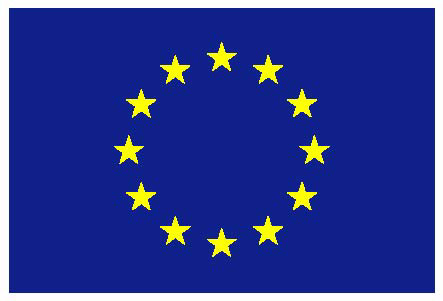EPIC will naturally build on results from a number of EU and national projects in which EPIC partners were actively involved in. A more detailed overview and description how EPIC may reuse their results or go beyond their objectives is given:
(Click on the '+' to expand/collapse projects)
Expand all | Collapse all
 EAR
EARThis project targets at developing antenna arrays at 100 GHz band with an on chip radiating design to provide for transmit-receive beam directivity. The project also investigates methods for simultaneous transmission over multiple users via polarization. The end goal of the project is to demonstrate the achievable throughput in an out-door lab environment. Similar to the other wireless Tb/s RF projects, this effort does not involve wireless Tb/s baseband development, and hence is complimentary to the EPIC technology
[Homepage]
 TERRANOVA
TERRANOVATo provide reliable connectivity of extremely high data rates in the Tbit/s regime and almost ‘zero-latency’ in networks beyond 5G, TERRANOVA proposes to extend the fibre-optic systems Quality of Experience and performance reliability to wireless, by exploiting frequencies above 275GHz for access and backhaul links. To this end, TERRANOVA will take advantage of breakthrough novel technology concepts, namely the design of baseband signal processing for the complete optical and wireless link, the development of H-band (>275GHz) RF front ends, as well as THz network information theory framework, channel and interference modelling in the THz regime, waveforms and high-order modulation schemes, pencil beam antenna arrays and multiple-access schemes and cashing techniques tailored to the particularities of the THz regime and the associated extremely large bandwidth.
[Homepage]
 ULTRAWAVE
ULTRAWAVEFor the first time, smartphones and tablets data usage exceeds desktops. This is a wake up call for manufacturers and operators to provide users with ubiquitous, high speed and high quality wireless coverage. The 5G cell densification is the only available route due to the constraints of sub-6GHz networks. A dense deployment of small cells requires a capillary backhaul and novel approaches to fronthaul. While the increase of data rate at small cell level has found solutions, the quest for high-density backhaul remains still unanswered. The fiber is too expensive and of difficult deployment. The wireless backhaul is the preferred solution for operators for performance, flexibility and cost. The traffic demand requires an upshift from microwave to high capacity millimeter wave backhaul, and overcome the current technology limits. ULTRAWAVE responds to the challenge of high capacity, high cell density backhaul by proposing, for the first time, the exploitation of the whole millimeter wave spectrum beyond 100 GHz.
[Homepage]
 NEREIDS
NEREIDSNEREIDS (New Service Capabilities for Integrated and Advanced Maritime Surveillance) is an FP7 Copernicus research and development project in the field of support to Maritime Surveillance. The project aimed to support the development of an integrated vision of Maritime Policy and Maritime Surveillance, with implications for a number of different maritime domains (Illegal trafficking, illegal immigration,fisheries control, piracy).
[Homepage]
 DREAM
DREAMNowadays there is a shared vision among industry, operators and academy that beyond 5G wireless networks will have to provide wideband wireless access and ubiquitous computing anywhere and at any time. The human life of the majority of the EU citizen will be surrounded by intelligent wireless sensors, which will bring radical changes to the way we live and do things. Supporting this scenario is a challenge for network operators and wireless network infrastructures and it will demand a tremendous performance improvement of medium range wireless infrastructure. This challenge needs to be addressed by a convergence of advanced semiconductor nanotechnology and a robust wireless infrastructure meshed network with seamless fiber performances.
[Homepage]
 WORTECS
WORTECS5G promises increased connectivity, high data rates, and ultimately new services. The first 5G release standard in 3GPP will be available by June 2018 with pre-commercial deployment in Korea soon after. Whilst 5G will meet current demand, the exponential rise in demand for wireless connectivity will ultimately require Tbps connectivity in indoor spaces. The future network will use an all optical fibre core, and an ultra-high data rate wireless ‘bridge’ to the User.
[Homepage]
 TERAPOD
TERAPODThe aim TERAPOD is to investigate and demonstrate the feasability of ultra high bandwidth wireless access networks operating in the Terahertz band. The project will focus on end to end demonstration of the THz wireless link within a Data Centre Proof of Concept deployment, while also investigating other use cases applicable to beyond 5G such as wireless personal area networks, wireless local area networks and high bandwidth broadcasting. The project seeks to bring THz communication a leap closer to industry uptake through leveraging recent advances in THz components, a thorough measurement and characterization study of components and devices, coupled with specification and validation of higher layer communication protocol specification.
[Homepage]
 LP100
LP100Focus of the project is the scientific investigation of near field wireless transmitters working on a carrier frequency of 60GHz and a bandwidth between 1 and 10 GHz. For a given energy per information bit, the overall energy consumption increases with the data rate. When targeting data rates in the region of 100 Gb/s, the overall system's power consumption gets a serious problem. Therefore, within this project transceivers are optimized to achieve a maximum data rate under a strict overall energy constraint which means the transmit energy as well as processing energy is limited for a given data rate.
[Homepage]
 B5G Cluster
B5G Cluster
Six projects from the H2020 call ICT-09-2017 (DREAM, EPIC, TERAPOD, TERRANOVA, ULTRAWAVE, WORTECS) have agreed to form an unofficial cluster in order to try to coordinate some dissemination activities to maximise the impact of the projects. This contribution provides some basic information in this cluster and the six projectsprovidessomebasicinformationinthisclusterandthesixprojects.
This presentation (given to the IEEE 802.15 THz Interest Group May-2018) gives a brief introduction to the cluster:
Introduction to the B5G cluster

